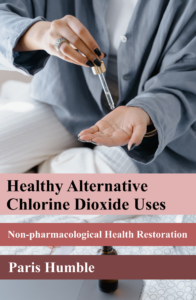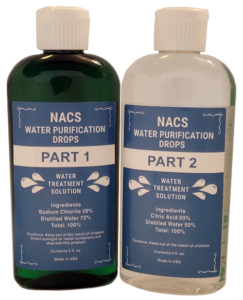Chlorine dioxide (CD) has been a topic of growing interest and debate, with proponents hailing it as a powerful remedy for various health issues. Often referred to as Master Mineral Solution (MMS), chlorine dioxide is praised for its potential in treating infections and other health conditions where conventional treatments have fallen short. However, its use remains controversial, and it’s essential to evaluate this compound’s safety and efficacy carefully.
What is Chlorine Dioxide?
Chlorine dioxide is a chemical compound with the formula ClO₂. It is a potent oxidizing agent used primarily for its disinfectant properties. Unlike chlorine bleach, a strong oxidizer that can form harmful by-products, chlorine dioxide does not produce carcinogenic chlorinated organics. This distinct chemical behavior makes it useful in various applications, including water purification and surface disinfection.
Approved Uses and Safety of Chlorine Dioxide
Chlorine dioxide has a well-established record of safety in specific applications. The FDA has approved its use as an antimicrobial agent in treating poultry, fruits, vegetables, red meat, seafood, and bottled water. The Environmental Protection Agency (EPA) also endorses its use for water purification. The World Health Organization (WHO) also supports its application in treating and purifying water.
In practical scenarios, chlorine dioxide has been used to address contamination issues, such as mold in the aftermath of hurricanes and anthrax contamination in high-profile incidents like the 2001 Capitol Hill scare. Despite its use in these contexts, it’s crucial to distinguish between its application as a disinfectant and its use as a health treatment.
Selective Action of Chlorine Dioxide
One of the compelling aspects of chlorine dioxide is its selective action. Chlorine dioxide (CD) is an oxidizer, targeting pathogens without significantly affecting healthy cells. This is because CD reacts with acidic, positively charged ions found on pathogens, leading to a breakdown of their structure. Research has shown that CD can effectively oxidize viral proteins, including those on SARS-CoV-2, the virus responsible for COVID-19.
This oxidative action means CD can destroy harmful microorganisms by disrupting and eliminating their proteins. Importantly, CD only activates upon contact with specific conditions found in pathogens, reducing the risk of harm to healthy cells with a neutral or slightly alkaline pH.
Safety and Misconceptions Re: Chlorine Dioxide
The safety of chlorine dioxide, particularly in medical or therapeutic contexts, is debated, especially in uses where the FDA prohibits it. While chlorine dioxide (CD) has been used effectively for water purification and as an antimicrobial agent, its use as a health treatment is not without controversy.
The New York Medical Authorities have restricted its use outside of medical supervision, authorizing it only for terminally ill patients who have exhausted all other treatment options. Authorities claim this caution is due to federal regulations, the potential risks associated with improper dosing, and the need for careful administration to avoid adverse effects.
Despite its approval for specific uses, CD is sometimes called “industrial bleach,” which can be misleading. While chlorine dioxide and bleach contain chlorine, their chemical properties and effects differ significantly. Chlorine dioxide does not form harmful chlorinated organics like bleach does and is designed to break down into compounds that are not harmful.
Studies and Applications Re: Chlorine Dioxide
Numerous studies have explored the potential benefits of chlorine dioxide (CD) in various health contexts. For example, research has indicated that CD can effectively treat conditions like malaria, typhoid fever, and HIV. It has also been used successfully in treating skin conditions such as eczema, psoriasis, and acne.
Chlorine dioxide has shown promise in clinical settings for improving symptoms in COVID-19 patients, with reports of significant improvements within 48 hours. However, such claims should be approached skeptically, and reliance on peer-reviewed research and professional medical consultation is advised.
How to Use Chlorine Dioxide
Proper protocols are crucial to ensure safety and efficacy for those interested in using chlorine dioxide. Chlorine dioxide (CD) is typically prepared by mixing drop(s) of sodium chlorite with an equal number of drop(s) of an activator such as citric acid and allowing it to “activate” for 30 seconds. This mixture is then diluted with water for consumption.
It is advisable to start with a low drop dose and gradually increase as tolerated. The recommended dosage varies depending on the addressed condition and the individual’s response. CD can also be used in other forms, such as in a humidifier for respiratory issues, ear drops for infections, or baths for skin conditions.
Precautions and Considerations
- Dosage: Proper dosing is crucial. High doses can be harmful and should be avoided. Chlorine dioxide (CD) should be used according to established protocols and under professional guidance.
- Interactions: Avoid combining CD with vitamin C or other antioxidants, as they can neutralize its effectiveness.
- Medical Supervision: Always use CD under the supervision of a qualified healthcare professional, especially for therapeutic purposes.
- Quality and Preparation: Use high-quality products and prepare chlorine dioxide before use to ensure its effectiveness and safety.
Chlorine dioxide has demonstrated notable efficacy as a disinfectant and antimicrobial agent. Its potential as a therapeutic tool for various health conditions is an area of ongoing research and debate. While some studies suggest it may offer benefits for treating infections and other ailments, its use should be cautiously approached. Always consult with natural healthcare professionals and rely on evidence-based practices when considering any new treatment options. Chlorine dioxide’s safety and effectiveness continue evolving, and staying informed is vital to responsible health decisions.
Resources:
- Master Mineral Solution for the Third Millennium by Jim Humble
- Chlorine Dioxide and Chlorite
- How to Use Chlorine Dioxide or MMS for Addressing Challenges
- EPA Chlorine Dioxide Safety and FDA Warnings
- Chlorine Dioxide Therapy
- Healthy Alternative Chlorine Dioxide Uses by Paris Humble
- Pathogenic Disease Chlorine Dioxide vs Parasite and Pathogen



